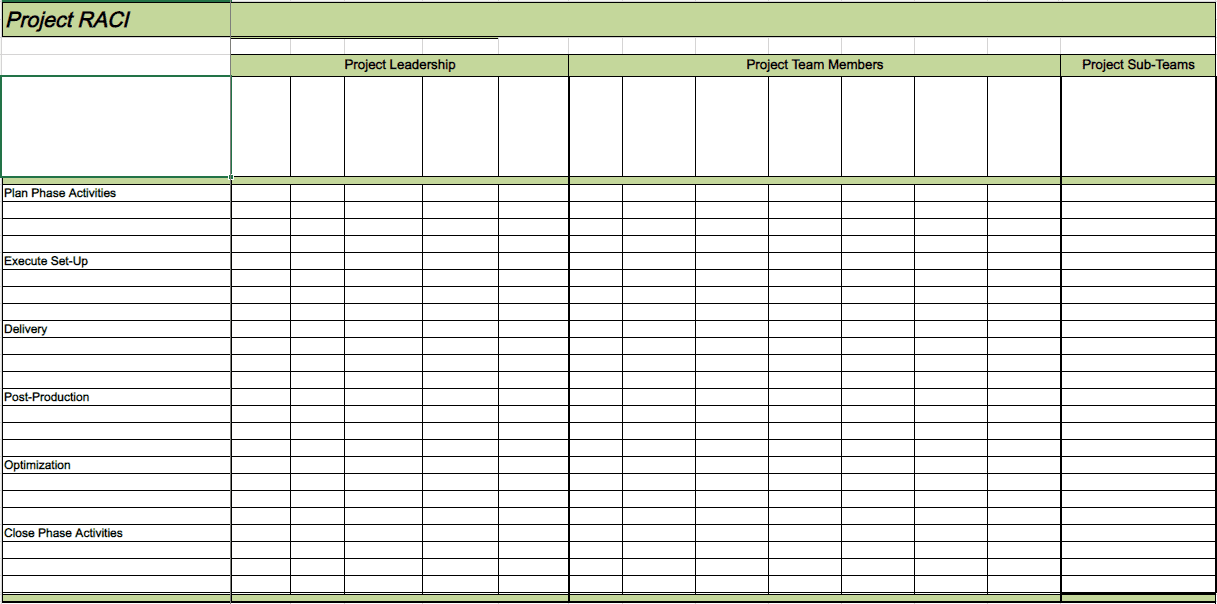Mindful Tips for RACI Application

By Sarah Threet, Marketing Consultant at Heinz Marketing
What is a RACI?
A Responsible, Accountable, Consulted, and Informed (RACI) matrix is a project management tool that helps define responsibility and accountability for every task/milestone in a project or campaign. In defining accountability, this tool helps set clear expectations through the workflow process.
(The RACI chart is a matrix with roles on one axis with tasks along the other access. Roles typically include the essential team, essential SMLT to be informed, a sponsor and/or advisor, subject matter experts (SME’s), and the project manager, but may also include external resources such as consultants, and sub-teams that include analysts and web. Role definitions are denoted with the RACI role letter.)
Defining the Roles
The roles that stakeholders may play in the RACI are:
The Responsible: is a manager or team member who is directly responsible for the successful completion of a project task. There may be multiple R’s for a task, but typically there should be one or very few to complete the objective.
The Accountable: is the person with the final authority over the successful completion of the specific task or deliverable. This person is the owner of the task and ensures that the execution of this step activates the following step.
The Consulted: is a person or role whose subject matter expertise is required in order to complete the deliverable properly. These people may serve as experts in the field, or the project may impact their own work.
The Informed: is a client or executive who isn’t directly involved but needs to be kept up to speed on the status of the project completion. They are typically leaders or stakeholders who may share the project status with other stakeholders. The Informed should not be included in meetings or in the review process, otherwise they would at least be considered a Consulted.
Some project managers prefer the RASCI matrix, which only differs in adding a Supportive role that takes the original Consultive role, defines it as ONLY supplying information, and defines the Supportive role as a consultant that takes on Responsibility (duties). Not all SMEs are messaging gurus, and the S role would likely be a communications specialist who is an expert on a given subject.
Purpose of a RACI
The purpose of this tool is to:
- Define roles and responsibilities
- Create accountability
- Reduce miscommunication and preemptively address misalignments
- Support the workflow and help prevent delays
- Ensure equal capacity across roles
How to Construct a RACI
Start by consulting the right people about your project and RACI. Gather the necessary decision-makers to the table to collaborate on defining the roles for the project. Ensure you bring in only the necessary decision-makers as too many hands in the pot will create delays.
Keep the design of your matrix readable and understandable through simplicity by only including the essential roles and essential informed stakeholders. Define the tasks by milestones rather than getting too granular; save more of those details for the workflow process.
Your matrix will have roles on one axis and project phases (tasks/milestones) on the other axis (see earlier example).
- Group your roles by leadership, essential teams, sub-teams, and maybe external resources.
- Group your tasks by project phases: pre-planning, planning, execution, delivery (inclusive of review), optimization, and close.
- Use the project plan to define the necessary tasks/milestones and be consistent with the language used in the project plan. Consistent language for milestones and tasks will further decrease the likelihood of any miscommunication.
Lastly, go through each task and ask yourself:
- Who is responsible for completing the task (the “doer”)? This is your Responsible. There may be multiple R’s for a task but be mindful of how many employees are being assigned to one task.
- For the task to be completed correctly, is there someone that needs to supply further information? This is your Consulted. They are generally SME’s. Once again, be cognizant of the number of employees who are being pulled in to consult on a deliverable as this may cause delays. Typically, most of the C’s are in the planning phase but otherwise there should be few (if any) per task.
- Who ensures that the task is done on time and correctly? This is your Accountable. There should only be one person accountable per task. More than one can cause a conflict in decision-making. Who has the final authority over the task completion and progressing to the next step?
- Who needs to be made aware of the progression of the project (milestones, decisions, updates) but isn’t directly completing anything or providing necessary information? This is your Informed. Frequently they will be leadership, but often you will want to inform certain team roles of a task completion because their task may be dependent on this task’s completion.
Mindful Tips for RACI Application
- Be flexible and adaptable; the RACI may be modified. Revisit the RACI to ensure that everyone is meeting their obligations, that no one person’s capacity is overloaded, and to redefine roles as needed. Over time, some steps may be added or removed from the process, people may leave and/or roles may be added or redefined. Change may be managed by using the RACI to clearly articulate how roles have been redefined.
- When distributing your RACI matrix, include a section with definitions for Responsible, Accountable, Informed and Consulted roles so stakeholders know exactly what to expect.
- When you review your initial RACI draft, note if there appear to be too many R’s and too many C’s. Can a Responsible be only a Consulted? Can a Consulted simply be Informed? Lean out your process for efficiency but don’t make it lean for the sake of being lean.
- If someone is designated as an Accountable person to a part of the process, then they must be held accountable if that part of the process does not get done on time or correctly. They must also be accountable for keeping the Informed up to speed if that is not automated.
- For every task/milestone there needs to be at least one person Responsible for the completion of that task and someone Accountable for the completion of the task. Review every task line and ensure that there is at least 1 R and an A. There should not need to be more than one person held accountable for each part of the process as that will overcomplicate decision-marking.
- Be mindful of too many Consulted on a task. It makes sense to have the most C’s at the pre-planning/planning stages as C’s are typically going to be SME’s, but too many C’s can lead to delays. Who is necessary to consult? Be mindful of this during the evaluation of your review process as well: who is necessary to review content?
- Informed employees need not be involved in any meetings; they only need to be kept apprised of the process. Involving them in meetings or anything else allows them the space to provide input, which means that they really are a C or an R. Who is necessary at a meeting? Time is money.






